When the trees start to slowly lose their leaves and autumn settles in, it means it’s that time of the year dedicated to making lard at home for the winter. It’s an easy process that can be done by anyone, but calls for knowing a few techniques.
Related: Canning Pasta Sauce for Long Term Preservation
So, today I will show you how you can make your own lard and 5 different ways of using it. Let’s get started!
First, you will need some fat. I will be using 11 lbs. of pig fat and a little bit of chicken fat.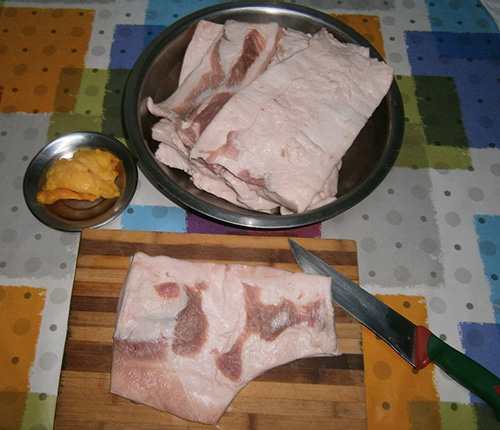
Place the fat on a cutting board and cut it into small cubes.
After cutting it all up, grab a normal pot and, first, add a cup of water because this way the fat won’t burn onto the pot.
Then, add the cubes of fat.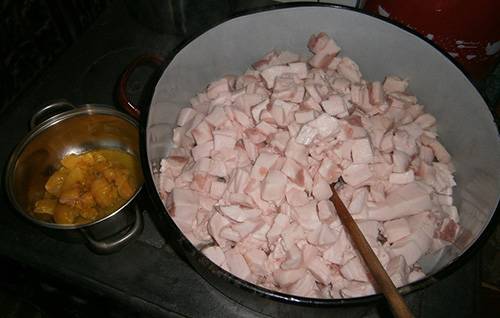
After placing everything inside, you can start melting the fat.
The cooking should take about 2 hours. When the fat cubes start to turn golden-brown and harden, take the pot off the fire. This is how it looked after the one-hour mark: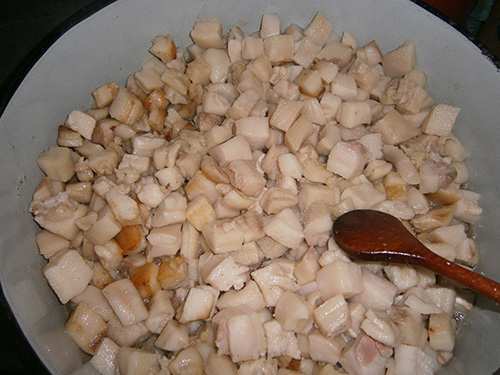
And the two-hour mark, when it was finished.
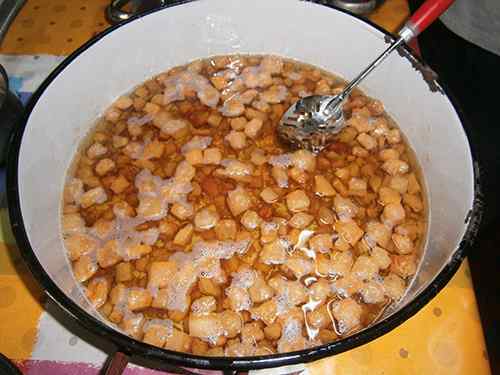
At this point, you will be left with two things:
- the melted fat,
- and greaves (which are a byproduct of the melted fat).
Both can be served warm or cold, depending on your preferences.
Here are the chicken greaves, after separating them from the fat:
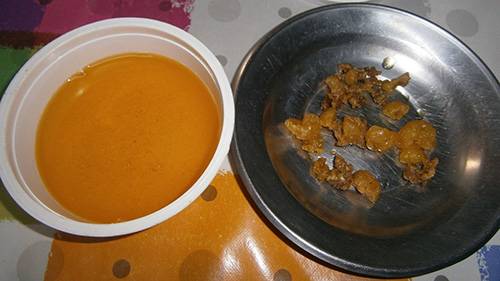
Using a potato masher, I was able to extract more fat from the greaves. Gently and slowly push the greaves down until most of the fat is being removed from the inside.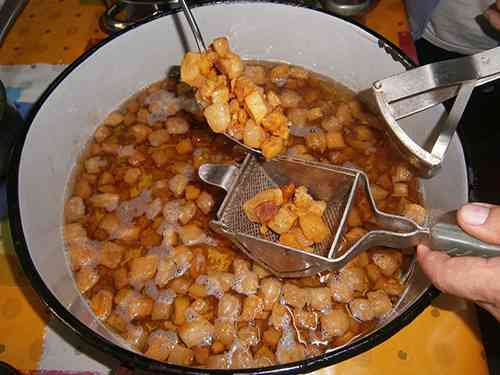
Do this while everything is still hot, this way you can remove the fat before it solidifies.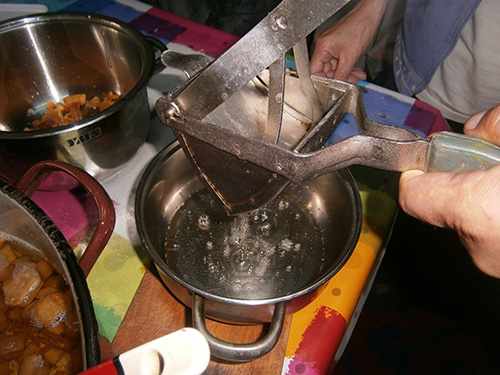
Now, remove the greaves from the potato masher. You can already see that they are way dryer than before.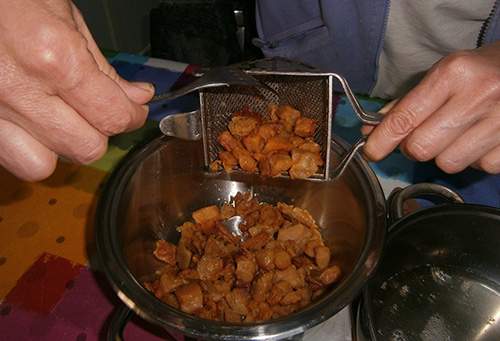
After finishing up, I was left with 2.20 lbs. of greaves and 3.5 liters of lard.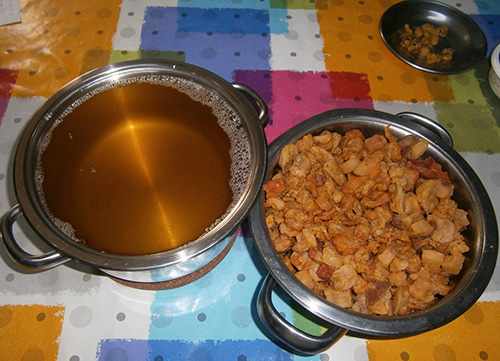
1. Eat as They Are
The greaves can be eaten by itself with some bread, salt, and onions.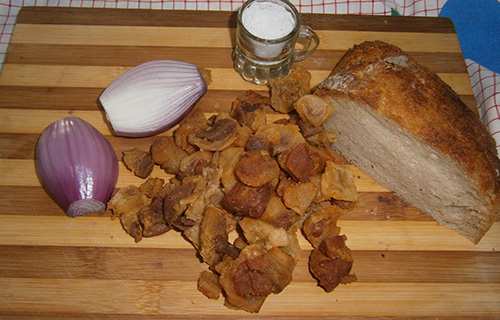
2. Tasty Spreading
Or you can make turn them into a spreading, following this recipe:
- 1 lb. of greaves
- 0.20 oz. of garlic
- 0.50 oz. of onion
- 3 teaspoons of mustard
- 1 teaspoon of (regular) pepper paste
- 1 teaspoon of ground pepper
- 1 teaspoons of salt
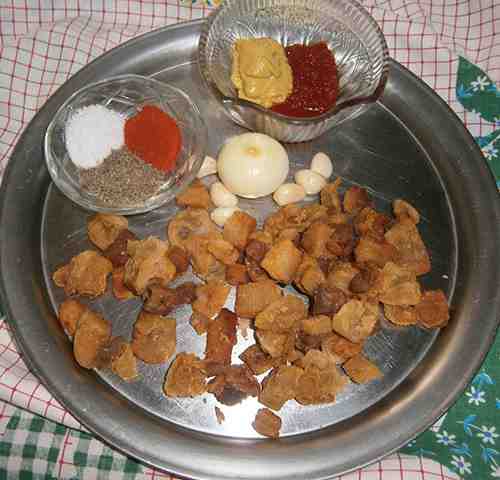
Using a meat grinder, you can create a paste that will surely fill your stomach. Of course, eat it with bread, onions, and salt. It’s extremely tasty and satisfying. 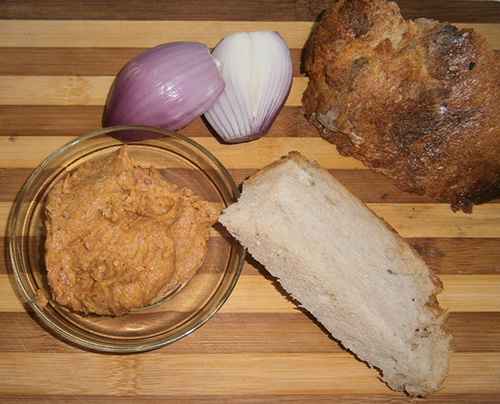
3. Greaves scones
You can also use the greaves for something more complex but twice as delicious. Greaves scones, which are great-tasting, salty scones, perfect to snack on while drinking a cold beer.
First, the ingredients:
- 0.55 lbs. of flour
- 5.50 oz. of grinded greaves
- 0.80 oz. of yeast
- 0.70 oz. of butter
- 2 eggs
- 1.5 teaspoons of salt
- 0.5 cups of milk
- 1 tablespoons of sour cream
- 1 teaspoons of sugar
Start by warming the milk on the stove, next add the sugar and the yeast. Mix everything else together (add the yolk of one egg only, the other egg and the rest of the egg white will be spread on top of the scones) in a bowl then add the milk to it. Mix it all together and let the dough rise for an hour in a warm place. Make small circular scones, cutting a grid on top of them. Finally, mix the egg white left from before together with the whole egg and brush it on top of the scones.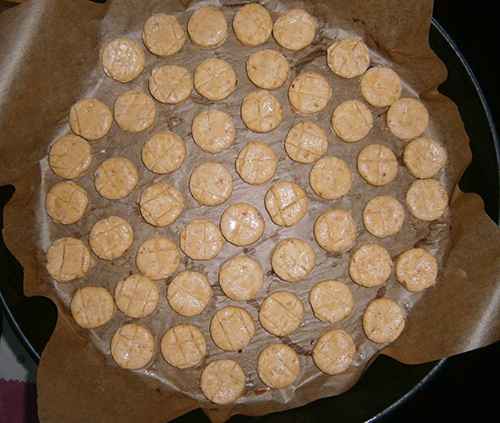
Finally, place the scones into the oven, cooking them until they all turn golden-brown.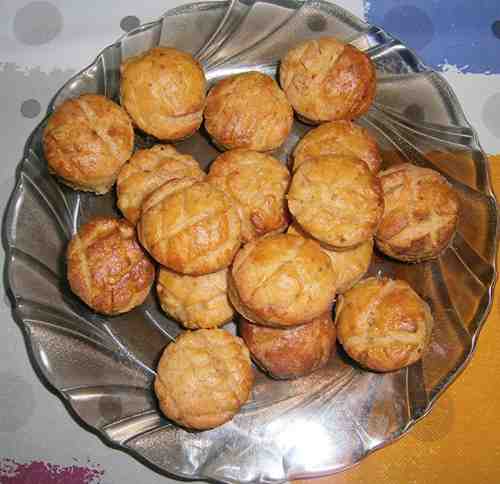
The lard we’ve previously collected will cool down slowly and solidify, getting a white color.
4. Lard on Bread
Spreading this on bread is one of the great ways to use it. Eat it with onions, salt and a little bit of pepper powder.
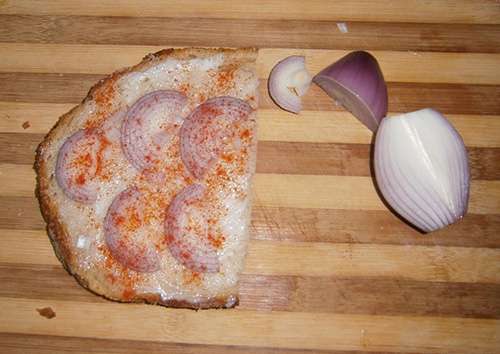
5. Pork in Lard for Long-Time Storage
If you have a few slices of pork, you might be able to make something that is not only delicious to be eaten fresh but can also be put away to stay fresh for half a year.
First, grab some of the solidified lard we’ve made and place it in a skillet.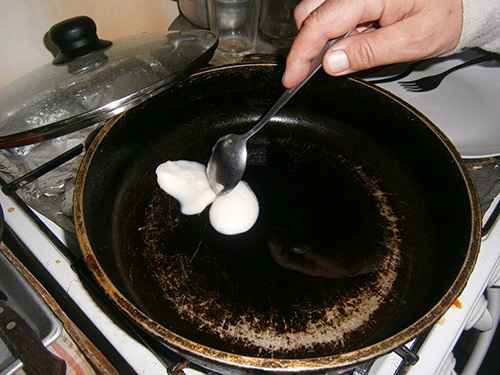
While the lard is getting hot, tenderize the slices and season it to your liking. After you are done, put it into fry.
Cook it a little, until it starts to change color, then take it out of the skillet and do the same with the rest of the slices.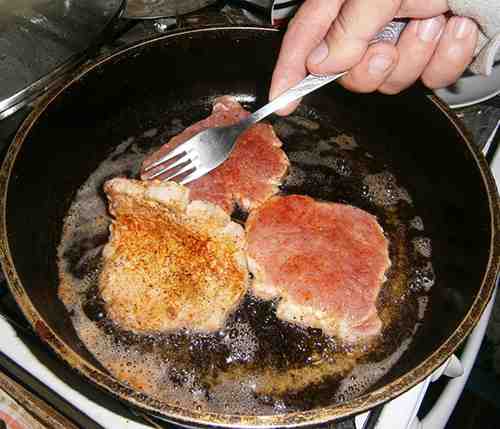
After all the slices are done, put it back onto the skillet with and lower the temperature. Add more lard and a little bit of garlic, onion, peppers, and tomatoes (or place vegetables in using your own taste).
Cook the slices until the meat dries. The drier the meat, the longer its shelf life will be.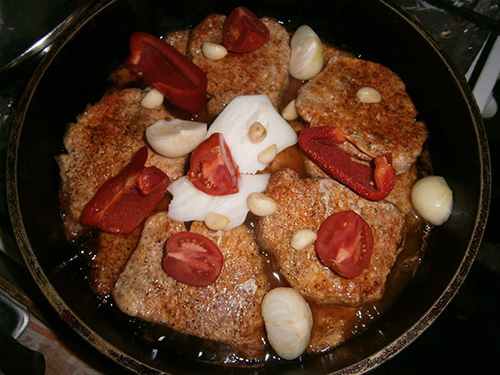
When we are finished with the meat, place them into a jar.
Add the lard we’ve fried the meat in for taste and to increase its shelf life.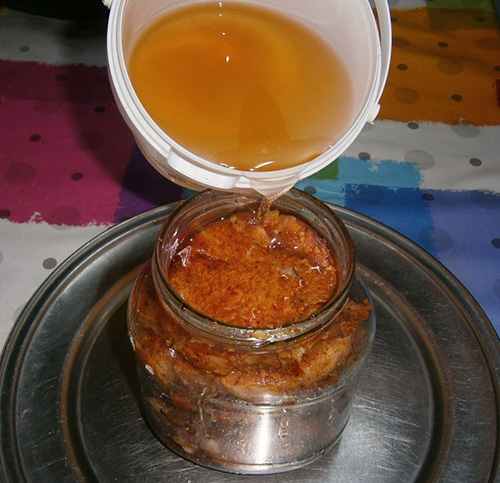
Put it away into a cold are, let it be a storage room or the fridge.
You may also like:
How To Make Your House Invisible To Looters (Video)
14 Must-Have Canned Foods You Didn’t Know Existed
Canning Amish Poor Man’s Steak
10 Long Shelf-Life Canned Foods Every Prepper Should Consider Stockpiling

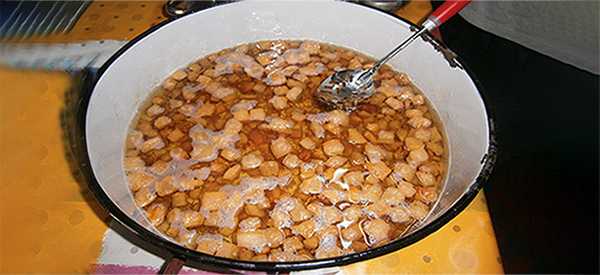














Thanks for reducing my ignorance about greaves, lard and their suitability for overwinter use. I’ll have to ask the butchers around here if they have access to pig fat, beyond what we get in bacon.
Can I use this lard for cookies etc instead of butter? My grandmother’s recipes often call for lard.
Thankyou!
Yes, I use lard when I make cookies. They stay softer longer than with butter or shortening. And I find that they turned a golden brown better without the edges being too dark.
“After cutting it all up, grab a normal and, first, add a cup of water”
I assume we are grabbing a normal pot or frying pan. Also, the recipe doesn’t indicate at what heat level the reduction is being done. I assume medium to low heat to avoid burning the meat.
This answers my question when we were discussing duck confit. Storing pork in lard is the same as storing duck meat in duck fat. So this recipe is actually for pork confit. Pemmican, with its fat content is somewhat similar and is also know for its long shelf life.
chicken fat is the best for baking, due to its lighter ‘weight’
and flavor. The greaves are also called cracklin’s.
A traditional use for cracklin’s here in Western NC is to bake some into cornbread. It’s called cracklin’ bread.
The original recipe for Toll House Cookies on the chocolate chip bag called for shortening, not butter. Later they changed it to butter, but the cookies weren’t as good, so I still use shortening. I presume lard would be more like shortening than butter.
I was always under the impression that you made lard only from grass fed BEEF. Not grain fed. And Never pork. Is there different kinds of lard? Or can you make lard from any kind of meat fat ?
Traditionally, lard comes from pork, tallow from beef (or sheep). These days, bought commercially, you may never be sure.
We make lard from our pigs slaughtered every year. We render ours down in several crock pots, you don’t have to watch them close, they don’t scorch the fat.
A 300lb pig (skinned) will typically yield a dozen or so quarts of really nice white lard. If one scalds/scrapes the pig (like old timers typically did), you can get quite a bit more yield.
Leaf lard, from the inner belly fat, makes the best pie crusts.
I guess I am an old timer as that is what we did in the 40-60. No one ever skinned a hog. We had a lard press to squeeze the maximum amount of lard from the cooked fat. We canned the tenderloin in lard. It was fried first, put in ball jars, and covered with melted lard. The jars were sealed and we stored them in our basement that had a natural spring run all the way across the dirt floor.
I am a proud farm girl. My part butchered pork & beef. Lard was rendered in a waist-high cast iron kettle, generations old, on a wood fire. The stirrers would slip a tenderloin (we called it a “catfish” because of shape) into the lard kettle to cook & slice; NOTHING BETTER. The lard went into 5-gal tins or crocks; pure white, reminiscent of the ‘“Little Rascals” episode that featured Alfalfa or Buckwheat eating lard because it looked like ice cream. The only times I purposely kept my two sons from school was during butchering. One thing they still talk of is what my Family called “hash”. No relationship to what would be meat, vegetables, etc. In an open kettle, on a wood fire in the chicken yard behind the smokehouse, with onions, celery, salt, pepper, maybe bay leaves, water to cover, went any pork trimmings & bones with meat clinging to them (tongue, heart, no liver). This kettle was added to all day, water & wood added as needed. After all meat cut, sausage ground, the ‘hash’ was made. Solids were strained from the kettle with long-handled pans into large, rectangular, gray-enameled pans & taken inside. By hand the meat mixture was separated from large & small bone fragments, put thru the sausage grinder into more large enameled pans, mixed with cooking broth until judged the right consistency, patted down firmly, & stored in our walk-in cooler to ‘set up’ until the next day (gelatin from bones solidified). This grayish meat was cut into square & freezer wrapped, to later be sliced, lightly browned in a skillet & served with a drizzle of vinegar (or syrup). I can not describe the one-of-kind flavor hash has (I’m beginning to salivate). I’ve tried to duplicate but it’s impossible without the all-day simmering over that wood fire (my Dad used hedge, O’sage Orange, wood). Would this have been something you are familiar with? As my older son says, he’d buy a hog and “put the whole thing into hash”; it truly is what I’d order for a last meal on death row. Crack Lin’s would be a mandatory side.
It sounds similar to Souse, which is also called Head Cheese. My mother boiled the hog head, without the brain, chopped the meat and pressed it in a loaf pan. It was delicious.
LARD comes from pork. TALLOW comes from beef.
Putting the fat thru a meat grinder rather than cubing it before rendering makes it MUCH easier to render it.
Lard is from pigs/hogs. From beef, lamb ECT is called tallow
tallow is beef. lard is pork. schmaltz is chicken (or can be made with any/all poultry/birds?). i think any other ruminant (deer, sheep, etc) is also referred to as tallow, but someone may correct me.
i remember my grandfather taking bacon grease sandwiches to work (no need for extra salt!) and also eating sliced raw garlic on buttered bread (with salt).
he had a heart attack behind the wheel of his car and died. not sure if there is any real connection to his diet, or to his sedentary lifestyle after he retired.
lard is the better choice over butter for pie crust also.
Tallow can also be made from mutton fat. Diane is correct. Tallow is from beef/mutton fat. Lard is from pork fat. I never knew the meaning of schmaltz. I knew it was a term that indicated cheap shoddy goods in colloquial Yiddish but didn’t know it was actually a product.
Hot bacon fat on sourdough bread is ambrosia. If you read Angela’s Ashes by Frank McCourt, you will learn that for poor (that means really destitute) urban Irish, breakfast often times consisted of bread soaked in bacon fat with tea as a beverage. McCourt attributes this diet to his poor eyesight as an adult.
I was reading a list of “poor folks” food. I never knew that tomato sandwiches were such. Nor did I know that hot dogs mixed into baked beans was also poor folks food. I guess I grew up as “poor folks” and maybe still am because I still like tomato sandwiches and hot dogs cut up in baked beans. There were several other foods that I don’t remember now that I ate growing up that I didn’t know made us “poor folks.”
“. I never knew the meaning of schmaltz. I knew it was a term that indicated cheap shoddy goods in colloquial Yiddish but didn’t know it was actually a product.”
SCHMELTZ is Yiddish word for cheap shoddy goods, and SCHMALTZ is a poultry fat.
Maybe it was the South Philly accent. I always thought it was schmaltz. Glad to know the correct word. Learned two new words today. I always called chicken fat “chicken fat”.
Schmaltz is the german term for lard. And we germans eat it as written above.we cook, bake and put it on bread.
I loved it as a kid,still to this day
Bacon was actually ‘poor folk’ food, too. When I was little it was the ‘meat’ that poor folk could afford. Now, its priced out of range for nearly everyone- as if its some kind of delicacy. There is very little meat in bacon, its largely fat nowadays. So, fat was not considered useful in a proper diet, in any amount, so bacon was made so as not to waste any part of the pork, and if a hog was fattened enough, it was not needed for the lard folks made- made an OK addition if smoked, to beans, etc.
Im 54 now but remember as a child, mom would cook up a bag of Mullers noodles then a pound of bacon. Crumble up the bacon with a couple tablespoons of the bacon grease and add it to the noodles. Still makes my mouth watter.
Diane, I just had a heart attack and the doctor said that one out of two men will get heart attack and one out of three women, will. So, it seems it is a life time of our veins getting plugged with plaque. We have a choice, keep your heart healthy, or destroy your liver and kidneys with STATINS! lol It seems not much choice, in avoiding heart attack. as one ages. I eat healthfully, oatmeal, etc. Did not make any difference for me.
If I get a choice, I would rather go like my father, my cousin and my uncle, a heart attack in their sleep than spend my days hooked up to a dialysis machine getting my kidneys pumped out.
I had to consult a cardiologist for high blood pressure. I asked him what would happen if I didn’t control it. He said, “You’ll die.” Well, that was scary. Did he mean if I controlled my high b.p. I wouldn’t die? I don’t think so.
My daughter put it in perspective. She said, “You’ll have kidney failure and have to spend every other day on a dialysis machine.”
Okay, that put a whole different slant on high b.p.
I brought down my bp to almost always normal with menhaden wild fish oil, I was ecstatic. No meds!
I resisted taking blood pressure medicine for several years and now have just 40% of my kidneys left. Take your daughter’s advice.
I resisted taking blood pressure medicine for several years and now have just 40% of my kidneys left. Take your daughter’s advice. Cutting back on salt and taking meds has helped me to keep what is left of my kidneys OK.
eat right, excersize, die anyway. I’ve been eating 2 local pastured eggs w grassfed butter to cook for about a year. 300 for total cholesterol, but my good cholesterol is really high, bad really low. they ran the possible cardiac risk formula and I came out at 6. heart problems occur at 60 level.
No One leaves this planet alive …Everything in moderation. Enjoy what ever is left of your life.,….
The question is, though, O.P. did you also eat out of cans, or prepared foods? 😀
Eat those veggies!!! Granny always harped on eating enough veggies. Most people in this country eat less than 4 half cup servings of veggies daily. That is not enough.
I’ve noticed that any time some snotty chef touts a ‘poor’ food, the price is soon so high you can’t afford to look at it.
All pork cuts, hamburger, winter squash, most fruits, etc.
I took statins for years and colesyterols were high normal or just over the line. Due to sever cramps I refused to keep taking it. I was advised to take Turmeric, Garlic, and Coconut oil. Last check up Cardiologist said he did not think my numbers were right. All normal and in about mid range. Arteries checked once a year, and they are clean. find a good Homeopath and see what he/she advises you to do. Phase in natural meds and take the poison as long as needed. Good luck
My typing is not much of a speller. Cholesterol
Because of a birth defect in my heart I had what was called a heart attack. They did a triple bypass and put me on statins. After a couple years my cholesterol was down to less than 100, I had severe leg cramps, and other vague symptoms. On the web I found Natural News. Mike Adams said not to take Statins. I stopped, started to eat a lot more garlic, and onions. Them I started to take Turmeric, green tea, and Cinnamon. My cholesterols are all very good. My cardiologist said your cholesterol panel is better than mine and I am over 30 younger than you. Do a search and find natural ways to control cholesterols, and other conditions where you do not need man made chemicals to cure one problem and create more that you did not have before you started to take the chemical cures.
It was never proven that high cholesterol causes hardening of the arteries. Big drug scam. I took Lipitor, tossed me right into a muscle disease called microchondrial myopathy. If you go deeper into research they tried their best to make a case for the statin drugs, which by the way are the worst drugs for you. My cholesterol runs in the 300’s. I go to our local hospital and for 99 bucks, they run all kinds of heart tests on you. Im always clear as a bell. I eat fat, i eat regular, i eat junk. Men do have a higher death rate. They don’t go to the dr. Wives nag and nag and men say, i feel fine. You can feel fine and have cancer, feel fine and have a crummy gallbladder. We women get checked out for all the scary things so we live longer. 🙂 i don’t think its all in healthy eating. I mean, eat cake! Most cannot afford, organic. I believe eating nonorganic is the biggest cause of cancer. When you go to cancer treatment centers of America, they put you on a 100% organic diet. I know a lot of fat people and they are healthy as can be. In my opinion, healthy organs are hereditary. I say, get your check up’s. Ask to have things checked out and eat organic as you can. Everything else is fluff in my head. Lol
I like sourdough bread with butter and salt on it. Just plain old white bread isn’t quite the same as sourdough. My father used to always eat bread and butter with sugar on it. He also likes to put vinegar and sugar on his salad. Got some raised eyebrows in restaurants with that but, hey, he was the customer. I have never tried sliced onions or garlic on buttered bread, although what else is garlic toast but buttered bread with garlic on it, and heated?
Thrivemarket.com is currently out of stock in pure lard, pure tallow and pure schmaltz. The lard is $12.00 and change for 14 oz. They have some other interesting food items for sale.
LCC I like crunchy peanut butter with a thick slice of red onion as a lunch or snack. Another good one is PB and a slice of bell pepper . The colors give it a different flavor. All time # 1 is PB and bacon.
i remember cooking a fruit dessert when i was a teen, that called for a biscuit topping when i was a teen. we always had bacon grease in the house, and knowing that bacon came from pigs and lard from pigs, i reasoned that they were the same and could be used interchangeably in cooking–frying or baking. my mother took one bite and put her fork down, then asked did i use lard in the biscuit topping. i answered i used bacon grease and wasn’t that lard? technically, it is, but bacon-flavored biscuits with fruit was a new taste treat. we had a good laugh, i learned a lesson, and we still ate the dessert. now i over compensate when trying to teach my kids to cook and don’t assume they can reason out every thing logically, cuz one and one doesn’t always add up to two!
Hawkeye, anything HYDROGENATED has added HYDROCARBON aka PETROLEUM, Usually in the form of food grade paraffin. It is normally a lighter grade of paraffin that is liquid rather than the blocks used for canning in the old days or for candle making.
Diane, I see no problem using bacon grease for any kind of biscuits. I would love the taste of the bacon for a dessert biscuit. It just adds a little more complexity to the flavor profile & not straining it is even better. Of course I think everything is better with bacon & you can never have too much of it.
Doesn’t the fat have to be strained to remove small particles that didn’t render? I suppose if one is going to store cooked meat in the fat, small particles of meat wouldn’t affect the storage factor. My mother, when she made shortening, whether lard or tallow always strained the fat through a sieve to remove small particles of meat. Thinking about it, if you were going to make pastry with the lard you wouldn’t want particles of meat in your fruit pastry, so straining through a fine sieve or cheesecloth might be in order. Thanks Diane for the story about bacon fat in fruit pastry.
We render our pork fat in crock pots and as the fat melts, ladle it into a fine mesh strainer also lined with cheese cloth….come out with nice, pure white lard.
hi lc chuck. i guess that must be why my mother only allowed me to take a bacon grease sandwich to school only one time. i thought it was okay, but not better than peanut butter and her homemade strawberry jam. and eating tomato sandwiches (or lettuce sandwiches, or tomato and lettuce sandwiches) is a summer favorite. that is the time for b l t’s also. and when we saved the most grease for frying onions, liver and onions (beef and chicken), eggs, zucchini and onions, and homemade buttermilk pancakes (to die for), which even my husband recalls fondly but won’t eat if i use it. and dogs and beans i thought were an american staple! i also wonder what other foods/recipes survived from the great depression that is cherished (and passed down). i also save my vegetable odds and ends, peels, etc., even egg shells, and when i have a gallon freezer bag full, i make vegetable stock. did you know that you can eat green (unripe) pumpkins that are too immature to ripen into orange. treat them like a summer squash. i like them better than zucchini, fried with onions (and olive oil these days. but my son refuses to eat eggs unless they are fried in bacon grease. my hubbie tried to serve him one cooked in o o, and he spit it out!)
hi again. l c chuck. we never made our own lard, and i didn’t know not to use bacon grease for baking, but rather the white rendered (and strained) lard. never occurred to me to strain the grease, since i shouldn’t have used it for baking anyway, unless you truly want bacon-flavored biscuits, just perhaps not for dessert.
Hi Diane: I don’t think I have ever had bacon flavored biscuits, but the idea is certainly attractive. Perhaps not for desert with a desert wine, but certain with eggs or tomato or even sausage — sort of a double shot of bad stuff for breakfast. I should have printed out that list of poor people’s food. Many of the people on this list might find it enlightening.
Fantastic work on the post and on the cooking. It’s a shame I don’t like lard.
I loved this, it dovetails with the notes from my grandfather’s journal and other journals created as the families came across on the wagon trains and life as they settled into Sherman County in Eastern Oregon. My wife & I did abridge the lard rendering, technique because we used an old Mamma Bear wood stove and had to adjust the bricks to maintain temperatures cool enough so as not burn the pig fat. Living next to an abandoned apple orchard on another occasion, we always had windfall apples from mid July through late November because of all the varieties grafted onto the trees.
According to the notes from one of my grandfather, a fall ritual was established where by his sausage recipe was used to make ground pork and link sausage for each of the families. His sausage recipe was so popular that at least one whole hog was added to the group to provide enough sausage. The fat was all rendered into lard and some of it canned. The notes are vague as to shelf life of pressure canned lard, though.
The notes also use a term apparently not covered here, or under a different designation, but suet was what I deduced to be strained rendered beef fat and was used in one of my mother’s desert recipes.
As my grandfather was a cattleman lifing on one of the main feeder canyons of the Columbia Basin and on the overland route the sheep herders had to take to reach Shaniko, the top sheep rail head in the world until the depression. His homestead was one of the primary sheep watering sites on the trail so tens of thousands of sheep traveled to that water and on through to the rail-head. None of the recipe books make reference to using sheep in any form. My grandmother was reported to sit on the porch with a shotgun across her lap when the sheep passed by her garden. I know of no anecdote of any sheep or sheep herder shot for trespassing in her garden and no recipes for lamb, mutton of rendered sheep fat. From that, I deduce that the sheep herders were diligent in controlling their flocks.
Yes, suet is made from beef fat. You can press birdseed into it, place it between hardware cloth wire the corners together and hang from a tree to make a bird feeder. It is especially loved by bluejays, but is eaten by other birds also. If you suspend it by small wire or brick twine, squirrels can’t steal it.
My mother always called the fat she hung out for birds in the wintertime “suet” but at this late stage I haven’t the foggiest what type of fat it was. She never put bird seed in it. We didn’t buy “pet food”. The animals always got what we ate that was scrap. The dogs got bones to gnaw on and other table scraps. Sometimes the cat did too although the cat was supposed to be self-sustaining by catching mice. Maybe the birds that came for the suet were additional snacks for the cat. I don’t know. I was a little young to be keeping track of things like that. I think I was in high school before we started buying food that was marked “dog food.” If it was on the floor it was dog food and they never wasted any time scrambling for it.
We have a local market that gives away pieces of beef fat free. They call it suet. I just put as is in a commercial suet feeder and the birds love it. If the package is too large to use at one time I freeze it in chunks that fit into the suet feeder to keep it fresh.
I believe suet is just unrendered beef fat. Once rendered, it is tallow.
Are you sure you don’t like lard? It’s what makes the best tamales – and other good things that you don’t associated with having ‘fat’ in them. Way back ‘when’, MacDonalds cooked all their french fries in BEEF FAT – and everyone raved about how good they were – and moaned when they substituted veggie oil because of the cholesterol scare.
In the South, we call the little crispy meat bits remaining in the lard “Cracklin’s or Cracklings” and use them for snacks and in cornbread batter to make cracklin’ bread. Both cracklin’s and bread can be frozen indefinitely They are wonderful with soup beans! Also, today I render lard in crock pots on low overnight, stirring occasionally. Saves labor and electricity or gas, plus I can use those burners & pots to boil the bones from our hogs to make soup stock which can be canned or frozen. The meat can be picked off bones when cool and added back to the broth. I add frozen veggies to it and can it for soup base. On those nights when we need supper in 15 min, I open the jar, add canned tomatoes, a handful of pasta, some diced potatoes, seasoning and serve with cracklin’ bread. Cooking like our grandparents? It’s not so hard!
My grandmother had a wood kitchen stove when I was growing up. I remember my grandmother “rendering” fat and the “cracklings”. We raised chickens, pigs and, once, a calf. We never raised another calf since we kids made a pet out of it and wouldn’t eat the meat. We used to pick wild berries which would be canned for winter pies. Tomatoes would be canned for winter use. The flavor of both the canned tomatoes and the berry pies was so much better than anything you can buy today. We always had a bushel of apples and a couple bushels of potatoes in the cellar. I now freeze berries and tomatoes in “can and freeze” jars. I had a cold cellar built into my new house so can keep apples and potatoes throughout the winter.
I remember back when I was in my 20’s (I’m in my early 60’s now) my Uncle raised 2 pigs. His wife didn’t want the fat, so he gave it to me. I put it through a meat grinder, put it in cast iron skillets and rendered it out in the oven at 200 degrees. It turned out great, it was very white,and it was still good a year latter when I used up the last of it.
My Granny cooked everything in lard. I don’t ever remember her buying any kind of cooking oils. Not ever! She made the best fried chicken, biscuits & gravy, beans and ham hocks. cornbread, flakiest pie crust you name it, it was cooked in lard. She lived to be 87, and so did my Grandpa.
The lard needs to be strained before it hardens. A flour sack towel draped over a colander will work. My mother kept her homemade lard in the freezer so it wouldn’t go rancid. I read this article to find out how to make lard last 2 years. Maybe the article was edited and that part was omitted. When the lard is finished cooking, fish out some of the hot cracklings and eat them on a piece of white bread: it’s delicious. Homemade lard is so much better than the Armour lard sold in the grocery store.
This was a great article with lots of informative posts by the readers. This article and the posts is the reason I regularly follow this website.
I’m a 76 yr. old Hungarian raised on Pork Fat. Always have a tub of it in the fridge.It’s tops in all meals & biscuits & pie Crusts. I really enjoy one particular meal we called soluna or speck. On a long rod, you placed a 1/4 lb. of fat back & over a wood fire, melted it & dabbed it on Rye bread. the blacker it got, the better. You then placed sliced tomatoes; cukes & onions on it, with a little of the Cracklings & you were in Heaven !
What a soothing article to read, and what heart-warming memories it has tapped in us!
I just spent 45 minutes of my life reading up on schmaltz. When we lived in Germany, every sit down restaurant we went to in the north had a little pot of schmaltz on it for your bread. It was usually bacon fat with little bits of cracklings in it, but sometimes it was goose fat or chicken fat. According to all the googled sites, “schmalz” = rendered animal fat. The distinction of the geographic or religious group makes schmalz = rendered chicken or goose fat if you are an Ashkenazic Jew, rendered pork fat if you are Polish, etc.
One note about the Armour lard you can buy in the stores: It has been hydrogenated [why? for longer shelf life?? — so it will already last 2 years?], so is really not healthy because of the trans fats, not because of the lard itself.
I am going to try the crockpot method. Sounds really easy!
Lucy: Hydrogenation is to insure longer shelf life. I’m not a nutritionist or organic chemist by any means, but it is my understanding that hydrogenation is what causes the development of transfat. If that is the answer for $64 million, don’t call on me as your expert.
I don’t like to eat meat fat and while I continue to read or hear all the pros and cons against or in favor of certain oils, fats, etc., I try to be flexible as the experts keep changing their minds as to what is healthy or not. For the purpose of survival or getting by it’s nice to know that the fat can be used for cooking as well making bird suet or homemade soap. I was thinking that the remnants (cracklins, greaves, etc.) could be dried or dehydrated and powdered to use as a flavoring or seasoning for breads, soups, and whatever else one might want to try it on… maybe chili, salads or mac and cheese. As long as one has fresh meat, maybe raises their own, they’ll have fresh cooking fat.
Suet is used in recipes for boiled or steaed puddings and Christmas pudding. My Mum used to buy some suet every year at the butcher’s for our Christmas pud., and I followed suit when I had a home of my own.
My family also had boiled suet puddings when I was growing up (I am 66 now). My mother stopped making them because they were so “fattening” and good suet became hard to find. There was a “Meat Pudding” that had suet in the outer dough with cubed chuck, onions, and potatoes in the middle. There was a “Christmas Pudding” which was a dough with suet, molasses, and various dried fruits. In both cases, the suet was in a minced form, not liquid or paste.
I was always told that what was needed for cooking was beef “kidney suet” (pure white in color) rather than the common suet (yellowish color). I have also seen suet as part of mincemeat recipes.
I got five pounds of pork fat from the local Von’s butcher shop. Tried to make lard. Was unimpressed with my efforts. First thing: read the d-d directions. I put the fat into the crock pot in chunks rather than cut it into small pieces. It toor forever to render down. I think I should have set the crock pot on high rather than low or not used it al all and used a cast iron skillet or frying pan. I left it in the crock pot overnight and the fat still was not nearly rendered out. I strained it through a strainer lined with coffee filters which I have found to work well in straining fluids. The resultant fat didn’t harden up and it wasn’t as white as my bacon fat. Don’t know what I did wrong, but am not going to try again until after the holidays. Any tips other than cut the fat into tiny pieces??
LC Chuck, it sounds to me as if you had back fat rather than kidney fat (leaf lard). The kidney fat will render whiter and become more solid than the back fat. You also want to be sure the pork fat is fresh.
And yes, I agree to cut it into tiny pieces. The greater surface area will allow them to render faster.
I don’t know if you’ve watched any of the Townsend videos (name changed from Jas. Townsend and Son to Townsend’s in the last year). They have lots of great videos about 18th century living and show how to render suet. Yes, that’s a little off-topic since we’re talking about lard in this article, but many of the steps are the same:
https://www.youtube.com/watch?v=ypRsO9KdxXk
We had a lard press. It allowed one to extract the maximum amount of lard from the cracklings. I loved to grab a hand full of the cracklings and go into the woods to roam and enjoy the good food. Bet the cardiologists would have a fit today to see one eat cracklings 2″ thick and in hand size pieces.
Grew up on that stuff for all of my 78 years, being 100% Magyar (Hungarian), Szalonna in Hungarian is what is called Lard in this country. Most important to remember is that one should never, never heat it till it smokes or catch it on fire because that’s when it becomes “hydrogenated”.
If that happens, don’t throw it out, it can then be used as a lubricant on squeaky door hinges, to waterproof your shoes, kept in your pocket when in the woods hunting for bear, or rubbed on a toilet seat as a party prank, thereby destabilizing accuracy.
Traditionally a shot of homemade “Palinka” (Whisky) is ingested with each slice of greasy bread, which is usually followed by either cheerfulness, or renewed arguments from the past among those present.
Hawkeye, anything HYDROGENATED has added HYDROCARBON aka PETROLEUM, Usually in the form of food grade paraffin. It is normally a lighter grade of paraffin that is liquid rather than the blocks used for canning in the old days or for candle making.
I like this article but lacks in some details, for example what temperature to use when rendering the fat. But you can find out to make homemade lard and many other SHLF stuff on YouTube
This is one that will blow your mind. Canned Jackfruit the reason for this it the vitamins Count exceeded just about everything you ever came across it has Vit A, C, Thiamin, Riboflavin, Niacin, Calcium, Potassium, Iron, Mangenses compared to most it has a very large amount of the above listed vitamins per ounce, and when SHTF proper diet for many will be a thing from the past. So a little help with this may make it better for you
This or last year…lard was discovered to be good for you!!!!…just like eggs or salt. It’s the carbohydrates and uncooked vegies that are bad for you. Vegies are often poisons, uncooked like green beans or green tomato.
Butter is good for you!! Modern plant oil margarine is bad…..the Margarine from 1880’s made with lard was good for you. “Poor man’s butter”.
I made it to 70 with a butter rich diet, just was checked, so heart wise, no thickening of the heart arteries; eating fat and buttery was ok….genes make the difference.
Once 70, 3 score and 10 was old, ain’t now, but if you die at 80 you are wrong….creeping around at 90 is the new old, and to reach it…according to folks that were wrong with butter, eggs, salt and pork fat; you are not allowed to have good tasting food for at least 40 years to make it to 90???? One has to survive to end up in the old folks prison…??? There is no dignity there, unless one is well off, so eat well ; drink and dance till you drop.
Eating good tasting food makes 80-5 sound like a fine end note. I intend to make it to 90 eating good tasting food…outside my noodles, rice and potatoes, which have to be limited. For my wife’s diet. (smilei)
I long ago decided some one decides what is bad for us by they try it do not like it, it is bad for us. I am afraid there is often little science in the decisions on what foods are good or bad for us. All things in moderation. You can kill yourself by drinking too much water.
I still use lard for cooking. Fried foods (Think Grandma’s fried chicken) have a taste that cannot be duplicated. Baked goods also have an absolutely wonderful taste. Cakes turn out more fluffy, as do any breads you wish to make. The problem when frying , using lard, is temperature. Use a temperature gauge or the way country folk did it (Drip a drop of water in it and if it pops, it’s ready for use.). Usually, pure lard is sold in the dairy section. The lard sold , on the the shelf, is most likely saturated, so that it will stay solid at room temperature. Enjoy.